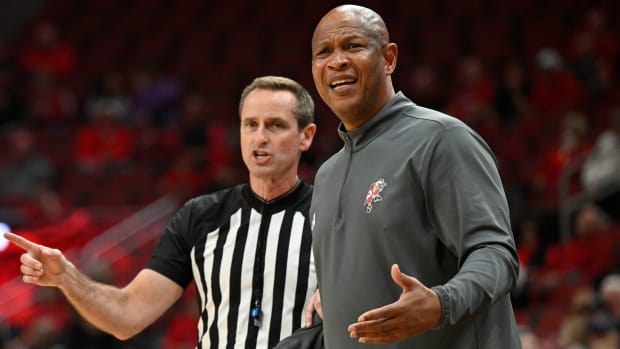The ACC’s Interest in California and Stanford Isn’t As Illogical As It Sounds
There would be nothing reasonable or rational about California and Stanford joining the Atlantic Coast Conference. But these are not reasonable, rational times. These are desperate times, and this would be a desperate measure—and perhaps also a useful life raft for all involved parties.
For more than a year, the ACC has mulled various ways to escape its media-rights revenue quagmire, a deal with ESPN that has increasingly impatient member schools locked in at a discounted rate until 2036. Part of the ACC’s assessment of options throughout the past year has involved the Pac-12 as a potential scheduling partner—or, as that league grew more imperiled this summer, as a potential merger/acquisition candidate. The conferences seemed to be on the verge of something big late last week until it collapsed at the last minute, with Pac-12 schools scattering to the Big Ten and Big 12.
The effect is potentially catastrophic for athletics at leftovers Cal, Stanford, Oregon State and Washington State. The latter two are, sadly for them, not serious ACC expansion candidates. The former two are.
ACC athletic directors met Monday to discuss adding the Golden Bears and Cardinal, and the league’s presidents are expected to do the same Tuesday. Sources described the discussions as preliminary, with plenty of work to do, but there is legitimate interest that could accelerate rapidly if a consensus develops.
Sources familiar with the ACC's deliberations confirmed to Sports Illustrated Tuesday that a third potential expansion candidate has been discussed: SMU, as was first reported by Yahoo Sports. However, those sources said evaluation of the Bay Area schools is further along and more substantive at this point, with more discussions of all three to come this week.
Cal and Stanford are elite academic schools, titans in Olympic sports and based in the populous and affluent Bay Area. Those things all matter to the ACC—apparently more than they mattered to the Big Ten, which punted on Cal and Stanford last week in favor of Oregon and Washington.
The Ducks and Huskies are more marketable football brands. The Golden Bears and Cardinal are, at present, middling football programs with dispassionate fan bases. In the current world where TV calls shots and university presidents follow orders, that was the apparent differentiator for the Big Ten.
The ACC, home to plenty of heavyweights academically and in nonrevenue sports, may actually recognize the nonfootball value that associating with Stanford and Cal can add. There certainly are people in the conference who are appalled to see those two institutions adrift. Commissioner Jim Phillips, a career college administrator who last year was mocked as a pollyanna for daring to prioritize issues other than expanding the College Football Playoff, doesn’t see things the same way as businessmen-commissioners Brett Yormark, Tony Petitti and Kevin Warren.
Of course, Cal and Stanford are on the opposite side of the country from an ACC footprint that is entirely in the Eastern time zone. It’s an inescapable problem for academics, cost and athlete welfare. But in the current climate, a shotgun marriage with myriad complications isn’t the worst potential course of action. Let’s examine why.
In college athletics’ Sherman-to-the-sea march toward a doomsday consolidation of power football programs, principles that historically held conferences together are all being destroyed. Tradition has been torched. Regionality has been razed. Academic peerage has been pillaged.
Are long-term contracts that bind schools to leagues the next element under siege? Is a legal bombardment designed to escape voluntarily signed agreements coming?
Looking at you, ACC.
Florida State threw an institutional tantrum last week, all but announcing its intention to quit the league as soon as it figures out how. From the school president to the trustees, the rhetoric sounded like something from the Secession Convention of 1861, when the state of Florida seceded from the union. (That convention happened in Tallahassee, in fact.) The public tirade annoyed other ACC members in bulk, many of whom wondered what the point was.
The grant of rights runs for another 13 years, meaning it likely would cost hundreds of millions of dollars to break it, not to mention engendering deep ill will. Then there is the question of where Florida State would go: The SEC is not in active expansion mode and already has the Sunshine State TV market in its portfolio via the University of Florida; the already bloated Big Ten might be a landing spot but FSU would have to be a revenue slam dunk. Further, would either league want to be party to a bitter and highly public legal battle waged by a potential expansion member?
Despite the apparent futility of Florida State’s public flex, it served as a reminder of the fault lines running beneath the league. In the spring, news broke that seven of the 14 football-playing members—Florida State, Clemson, Miami, North Carolina, North Carolina State, Virginia and Virginia Tech—had met to explore options outside the ACC. That triggered some tense face-to-face meetings and ultimately led to the league approving unequal revenue distribution to schools that had success in the College Football Playoff and NCAA basketball tournament.
That agreement calmed things down … for a while. Florida State stirred it up again. While the ACC grant of rights deal is hardly flimsy, it seems increasingly likely that a member (or multiple members) will mount a challenge to break it if the current revenue distributions hold.
In a logical system, there would be no good reason to destabilize the ACC, which was established 80 years ago and is a legitimate No. 3 league by just about any applicable metric. The ACC has had great athletic success in the last decade (three football national championships, three men’s basketball titles, a nation-leading nine all-sports nattys in 2022–23 alone). Those titles somehow were won despite being at a revenue deficit compared to the Big Ten and SEC, by the way.
But we are well past the point of needing a good reason and financial justification to mow down a conference. At the behest of the TV network overlords, two leagues are putting the squeeze on everyone else: Fox’s Big Ten and ESPN’s Southeastern. As the Pac-12 just found out, competitors will be pillaged as needed. As was the case during William T. Sherman’s Savannah Campaign of 1864, total annihilation is the business plan.
And the only remaining league with highly prized potential additions is the ACC. No disrespect to the Big 12, which has made a remarkable comeback from the brink of death just two years ago, but that conference is largely stocked with B-listers who are stronger together than apart.

North Carolina and Virginia are the two ACC schools with the best all-around appeal for the Big Ten and SEC alike.
Scott Taetsch/USA TODAY Sports
Assuming Notre Dame is off the table, the remaining schools that dilate the pupils of TV execs, conference commissioners and university presidents alike in both the Big Ten and SEC are ACC bedrock members North Carolina and Virginia. In that order. They represent new media markets for both the SEC and Big Ten, they have academic clout, they win national championships in both men’s basketball and Olympic sports, and they’re not geographically ridiculous additions.
Football-first schools Florida State, Clemson and Miami would be considered as well, though all of them would face resistance from current SEC members in those states if that league showed interest. (Then again, Texas A&M’s resistance to Texas was steamrolled by market forces and commissioner Greg Sankey.)
With a static media deal, restless league members and schools that the Big Ten and SEC would covet, the ACC probably needs to shake up its status quo. Along come Cal and Stanford, who can offer the previously mentioned attributes and one more key element: access to the late-night Friday and Saturday TV window. People watch those football games, and they could provide the elusive mechanism to reopen the ACC’s TV deal with ESPN to add more revenue.
How much more? Perhaps not significantly, and thus perhaps not enough to calm conference waters. But if there is any improvement of the bottom line, that might lessen the ardor of malcontents who want to take on the bloody fight of breaking away from the league.
With that late-night window would come 10:30 p.m. Eastern Time kickoffs in California for some teams from the East Coast. And with a move to the ACC, Cal and Stanford would have 9 a.m. body-clock kickoffs for some away games. Olympic sports travel would be every bit as challenging in this league as it will be for the West Coast schools joining the Big Ten.
Those issues cannot be dismissed or easily fixed. But once the Big Ten and Big 12 reduced the Pac-12 to rubble, further realignment became a reclamation project. Saving Stanford and California athletics helps college athletics as a whole—and it could help the ACC in specific.






















